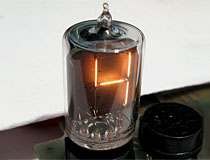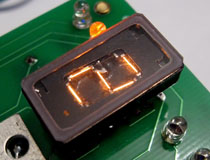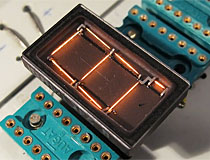
 |
| Filament Displays |
Filament displays were a niche alternative to the neon Nixie tubes that were the numeric display of choice during the 1960s. Sometimes sold under the brand name of Numitron, a filament display uses thin low voltage wires sealed in a vacuum to generate a lighted digit, similar to the way a lightbulb works. Unlike Nixie tubes, filament displays use a very low voltage, normally five volts or less, which makes them ideal for interfacing with modern TTL chips. |
|
| IEE Apollo DA2010 Series | |
Devices included in this entry: IEE Numitrons Datasheet (PDF, covers numerous devices, including the DA2010 and DA2020) |  |
| IEE Apollo DA-2110 | |
The DA-2110, manufactured by IEE, is a subminiature version of the larger and more common DA-2010 filament display. This tube contains a small seven segment filament display with decimal point and has a nine pin flying lead base. As with the DA2010, the DA2110 has holes in its plate for a plus symbol that are unused in this model of tube. RCA also made a variant of this display, the DR2110. The RCA version is almost identical to the IEE tube, with the exception of a slightly thicker support wafer for the filaments. IEE Numitrons Datasheet (PDF, covers numerous devices, including the DA2010 and DA2020) |  |
| Fuji 3015F | |
A minitron is an advancement of filament display technology that follows the same evolutionary step as a panaplex neon display. Instead of being sealed into a tube, minitrons are constructed into rectangular DIP-style envelopes that can be easily integrated into modern circuit layouts. The 3015-F is a fairly standard example of such a device: it has a glass front bonded to a sheet metal case, which is covered with a removable plastic cover. This model of minitron was manufactured in at least two different styles, one of which has a black matte around the display area. Digit height on the 3015F is 10mm and the package is 23mm long from end to end. When operated at 5VDC, the 3015F is rated for 50,000 hours of continuous operation. 3015F / 3015G Datasheet (PDF, 173kb) |  |
| IEE Aurora FFD21 & FFD51 | |
Devices included in this entry: IEE also made a high brightness version of the FFD21; the FFD51. The FFD51 is more than twice as bright on a per segment basis, and outputs 13,000 fL compared to the FFD21's 4,500fL. The display's lifespan is significantly reduced as a result however; the FFD51 is only rated to operate for 40,000 hours. IEE Aurora Family Devices Datasheet (PDF, 95kb) |  |
| IEE Aurora FFD61 & FFD81 | |
The IEE Aurora FFD61 and FFD81 devices are large, attractive minitron displays packaged in a bathtub-style metal hermetic shell. These displays have the same 17mm digit height and 21 pin basing pattern as IEE's large ceramic displays like the FFD21. Despite being advertised as a ruggedized version of the FFD21, these metal-clad displays are actually more susceptible to damage... striking the side or edge of the display tends to deform the metal and break the metal-on-glass seal. The FFD81 is rated for 100,000 hours of service at 5 volts, though on a display this large the filaments will start to 'sag' from the pull of gravity after only about half that time. The modern builder should consider building projects that allow the displays to be rotated 180 degrees periodically, which can increase the useful lifespan of these devices by several years. Interestingly, the FFD61 is not included in the standard Aurora databook, but we suspect this device is a lower brightness version of the FFD81. IEE Aurora Family Devices Datasheet (PDF, 95kb) |  |
| ©2000-2025 Industrial Alchemy. All rights reserved. | Switch to mobile version | Contact | |  |